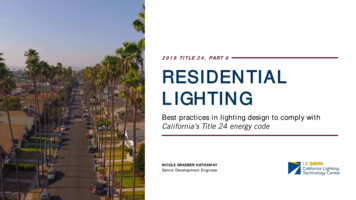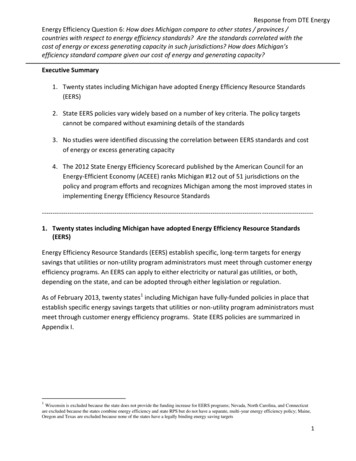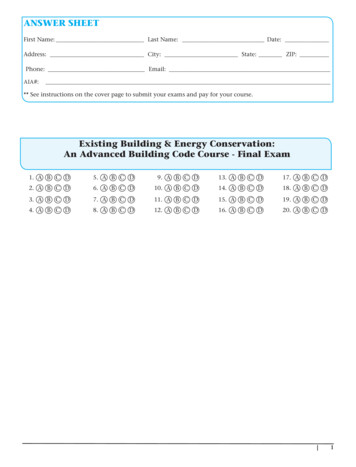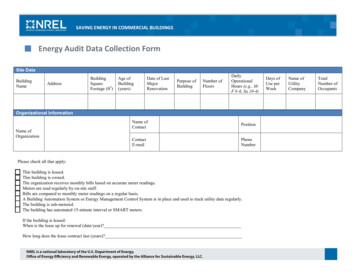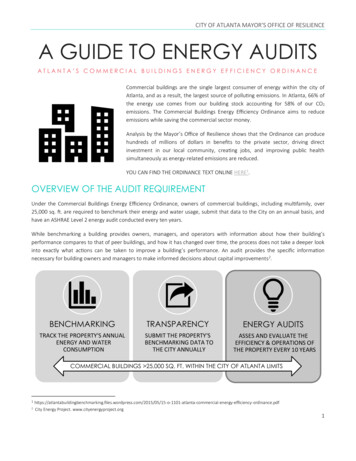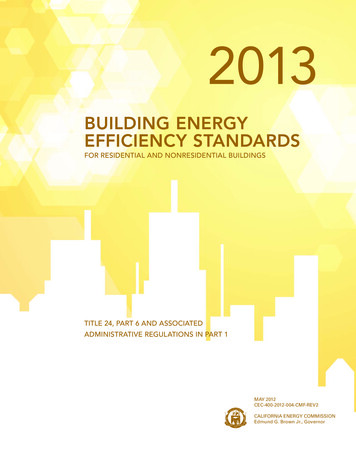
Transcription
2013BUILDING ENERGYEFFICIENCY STANDARDSFor Residential and Nonresidential BuildingsTitle 24, Part 6 and AssociatedAdministrative Regulations in Part 1MAY 2012CEC‐400‐2012‐004-CMF-REV2CALIFORNIA ENERGY COMMISSIONEdmund G. Brown Jr., Governor
John LairdSecretary for Natural Resources AgencyCALIFORNIA ENERGY COMMISSION:Robert Weisenmiller, Ph.D.ChairmanCommissioners:Andrew McAllisterKaren Douglas, J.D.David HochschildJanea A. Scott, J.D.Robert P. OglesbyExecutive DirectorDavid AshuckianDeputy DirectorEfficiency and Renewable Energy DivisionBill PenningtonDeputy Division ChiefEfficiency and Renewable Energy DivisionEurlyne GeiszlerOffice ManagerHigh Performance Buildings OfficeProject Managers:Maziar Shirakh, P.E.High Performance Buildings Office
(This page left intentionally blank)
ERRATAHISTORYThe Revised 2013 Building Energy Efficiency Standards for Residential andNonresidential Buildings to be effective on July 1, 2014 now include the followingEnergy Commission approved and adopted Nonsubstantive errata:- Nonsubstantial Errata – November 2013- Nonsubstantial Errata - September 2013- Supplement to Nonsubstantial Errata - December 2012- Nonsubstantive Errata - May 2012
(This page left intentionally blank)
ABSTRACTPublic Resources Code Sections 25402 and 25402.1 were enacted in 1975 as part of the enablinglegislation establishing the California Energy Commission and its basic mandates. Thesesections require the Energy Commission to adopt, implement, and periodically update energyefficiency standards for both residential and nonresidential buildings.The Standards must be cost effective based on the life cycle of the building, must includeperformance and prescriptive compliance approaches, and must be periodically updated toaccount for technological improvements in efficiency technology. Accordingly, the CaliforniaEnergy Commission has adopted and periodically updated the Standards (codified in Title 24,Part 6 of the California Code of Regulations) to ensure that building construction, system designand installation achieve energy efficiency and preserve outdoor and indoor environmentalquality. The Standards establish a minimum level of building energy efficiency. A building canbe designed to a higher efficiency level, resulting in additional energy savings.The 2013 Building Energy Efficiency Standards focus on several key areas to improve theenergy efficiency of newly constructed buildings and additions and alterations to existingbuildings, and include requirements that will enable both demand reductions during criticalpeak periods and future solar electric and thermal system installations. The most significantefficiency improvements to the residential Standards are proposed for windows, envelopeinsulation and HVAC system testing. The most significant efficiency improvements to thenonresidential Standards are proposed for lighting controls, windows, unitary HVACequipment and building commissioning. New efficiency requirements for process loads such ascommercial refrigeration, data centers, kitchen exhaust systems and compressed air systems areincluded in the nonresidential Standards. The 2013 Standards include expanded criteria foracceptance testing of mechanical and lighting systems, as well as new requirements for codecompliance data to be collected in a California Energy Commission‐managed repository.The 2013 Standards also include updates to the energy efficiency divisions of the CaliforniaGreen Building Code Standards (Title 24, Part 11). A set of prerequisites has been establishedfor both the residential and nonresidential Reach Standards, which include efficiency measuresthat should be installed in any building project striving to meet advanced levels of energyefficiency. The residential Reach Standards have also been updated to require additionalenergy efficiency or on‐site renewable electricity generation to meet a specific threshold ofexpected electricity use. Both the residential and nonresidential Reach Standards includerequirements for additions and alterations to existing buildings.Energy Commission staff estimates that the implementation of the 2013 Building EnergyEfficiency Standards may reduce statewide annual electricity consumption by approximately613 gigawatt‐hours per year, electrical peak demand by 195 megawatts, and natural gasconsumption by 10 million therms per year. The potential effect of these energy savings to airquality may be a net reduction in the emission of nitric oxide by approximately 59 tons per year,
AcknowledgmentsThe Building Energy Efficiency Standards (Standards) were first adopted and put into effect in 1978and have been updated periodically in the intervening years. The Standards are a unique Californiaasset and have benefitted from the conscientious involvement and enduring commitment to thepublic good of many persons and organizations along the way. The 2013 Standards developmentand adoption process continued that long-standing practice of maintaining the Standards withtechnical rigor, challenging but achievable design and construction practices, public engagementand full consideration of the views of stakeholders.The 2013 Standards revision and the supporting documents were conceptualized, evaluated andjustified through the excellent work of Energy Commission staff and consultants working undercontract to the Energy Commission, Pacific Gas and Electric Company, Southern California EdisonCompany, San Diego Gas and Electric Company, and Southern California Gas Company. At theEnergy Commission, Maziar Shirakh, P.E.; and Martha Brook, P.E. served as the project managersand senior engineers. Bill Pennington, Deputy Division Chief of the Efficiency and RenewableEnergy Division, provided overall guidance to the staff and consultants. Eurlyne Geiszler served asthe Office Manager for the High Performance Buildings Office. Pippin Brehler and Kristen Driskellprovided legal counsel to the staff. Other key technical staff contributors included, Gary Flamm;Patrick Saxton P.E.; Jeff Miller, P.E.; Payam Bozorgchami, P.E.; David Ware; Tav Commins; RobHudler; Owen Howlett; Danny Tam; and Nelson Pena. Additional staff input and assistance camefrom Ron Yasny; Seran Thamilseran; Brian Samuelson; Chris Olvera; Jim Holland; Todd Ferris; JoeLoyer, Alan Marshall; the Energy Hotline staff; and the Energy Commission’s Web Team. KeyEnergy Commission and CASE consultants included Architectural Energy Corporation, BruceWilcox, Taylor Engineering, Proctor Engineering, Benya Lighting Design, Chitwood EnergyManagement, Davis Energy Group, EnerComp, McHugh Energy, Energy Solutions, E3, PECI, andthe Heschong Mahone Group.The authors are grateful to the many people and organizations that contributed to the developmentand production of the Standards and the supporting documents. The documents reflect, to a largeextent, the comments made by the many people who took time to carefully review earlier versions.Reviewers who significantly contributed to the content include members of CABEC and CALBO.Special thanks go to Panama Bartholomy, the former Deputy Director Efficiency and RenewableEnergy Division for his vision and support of the 2013 Standards.The Energy Commission dedicates the adoption of the 2013 Building EnergyEfficiency Standards to Valerie T. Hall, (November 28, 1952 - December 21, 2010),Deputy Director of the Efficiency and Renewable Energy Division for her more than 32years of dedication to excellence in the development and implementation of energyefficiency programs in California with the most aggressive energy efficient buildingstandards in the country and for being a model for others to follow.
sulfur oxides by 2.4 tons per year, carbon monoxide by 41 tons per year and particulate matterless than 2.5 microns in diameter by 10 tons per year. Additionally, Energy Commission staffestimates that the implementation of the 2013 Standards may reduce statewide carbon dioxideequivalent emissions by 215 thousand metric tons per year.Energy Commission staff have completed an analysis of the environmental impacts of theproposed 2013 Building Energy Efficiency Standards for residential and nonresidentialbuildings. In addition to air emissions, issues of on‐site water use, indoor air pollution andchanges in materials use including: Mercury, Lead, Cooper, Steel, Plastic Silicon, Gold,Aluminum, Fiber Glass, Titanium, Glass and Wood were considered. It is the opinion of EnergyCommission staff that the potential environmental impacts that may be associated with theimplementation of the 2013 Building Energy Efficiency Standards are less than significant.Therefore, Energy Commission staff recommends the adoption of a Negative Declaration for the2013 Building Energy Efficiency Standards.Key Words:California EnergyCommission,California Building EnergyEfficiency StandardsTitle 24, Part 62013 Building EnergyEfficiency StandardsCalifornia Green BuildingCode StandardsTitle 24, Part 11Negative DeclarationResidentialNonresidentialNewly ConstructedAdditions and Alterationsto Existing velope InsulationHVACBuilding CommissioningProcess LoadCommercial RefrigerationData CenterKitchen ExhaustCompressed AirAcceptance TestingData CollectionCool RoofReach StandardsOn‐site RenewableElectricity GenerationGiga‐watt hoursMega‐WattTherms per yearNitric OxidesSulfur OxidesCarbon MonoxideCarbone rSteelPlasticSiliconGoldAluminumFiber GlassTitaniumGlassWoodTime DependentValuationTDV
(This page left intentionally blank)
2013 Building Energy Efficiency StandardsPage iTable of ContentsADMINISTRATIVE REGULATIONS .1CALIFORNIA CODE OF REGULATIONS TITLE 24, PART1 .1ARTICLE 1 – ENERGY BUILDING REGULATIONS .1SECTION 10-101 – SCOPE . 1SECTION 10-102 – DEFINITIONS . 1SECTION 10-103 – PERMIT, CERTIFICATE, INFORMATIONAL, AND ENFORCEMENT REQUIREMENTSFOR DESIGNERS, INSTALLERS, BUILDERS, MANUFACTURERS, AND SUPPLIERS . 5SECTION 10-103-A – NONRESIDENTIAL LIGHTING CONTROLS ACCEPTANCE TEST TRAINING ANDCERTIFICATION. 14SECTION 10-103-B – NONRESIDENTIAL MECHANICAL ACCEPTANCE TEST TRAINING ANDCERTIFICATION. 17SECTION 10-104 – EXCEPTIONAL DESIGNS. 22SECTION 10-105 – ENFORCEMENT BY THE COMMISSION . 23SECTION 10-106 – LOCALLY ADOPTED ENERGY STANDARDS . 24SECTION 10-107 – INTERPRETATIONS. 25SECTION 10-108 – EXEMPTION . 26SECTION 10-109 – COMPLIANCE SOFTWARE, ALTERNATIVE COMPONENT PACKAGES,EXCEPTIONAL METHODS, DATA REGISTRIES AND RELATED DATA INPUT SOFTWARE, ANDELECTRONIC DOCUMENT REPOSITORIES . 27SECTION 10-110 – PROCEDURES FOR CONSIDERATION OF APPLICATIONS UNDER SECTIONS 10-104,10-106, 10-108, AND 10-109 . 29SECTION 10-111 – CERTIFICATION AND LABELING OF FENESTRATION PRODUCT U-FACTORS,SOLAR HEAT GAIN COEFFICIENTS AND AIR LEAKAGE . 30SECTION 10-112 – CRITERIA FOR DEFAULT TABLES. 33SECTION 10-113 – CERTIFICATION AND LABELING OF ROOFING PRODUCT REFLECTANCE ANDEMITTANCE. 33SECTION 10-114 – DETERMINATION OF OUTDOOR LIGHTING ZONES AND ADMINISTRATIVE RULESFOR USE . 36EFFICIENCY STANDARDS CALIFORNIA CODE OF REGULATIONS TITLE 24, PART 6 .38SUBCHAPTER 1 ALL OCCUPANCIES—GENERAL PROVISIONS .39SECTION 100.0 – SCOPE. 39SECTION 100.1 – DEFINITIONS AND RULES OF CONSTRUCTION . 44SECTION 100.2 – CALCULATION OF TIME DEPENDENT VALUATION (TDV) ENERGY . 75SUBCHAPTER 2 ALL OCCUPANCIES—MANDATORY REQUIREMENTS FOR THE MANUFACTURE,CONSTRUCTION AND INSTALLATION OF SYSTEMS, EQUIPMENT AND BUILDING COMPONENTS76SECTION 110.0 – SYSTEMS AND EQUIPMENT—GENERAL . 76SECTION 110.1 – MANDATORY REQUIREMENTS FOR APPLIANCES . 77SECTION 110.2 – MANDATORY REQUIREMENTS FOR SPACE-CONDITIONING EQUIPMENT . 78SECTION 110.3 – MANDATORY REQUIREMENTS FOR SERVICE WATER-HEATING SYSTEMS ANDEQUIPMENT. 92Table of Contents
Page ii2013 Building Energy Efficiency StandardsSECTION 110.4 – MANDATORY REQUIREMENTS FOR POOL AND SPA SYSTEMS AND EQUIPMENT 94SECTION 110.5 – NATURAL GAS CENTRAL FURNACES, COOKING EQUIPMENT, AND POOL AND SPAHEATERS: PILOT LIGHTS PROHIBITED . 95SECTION 110.6 – MANDATORY REQUIREMENTS FOR FENESTRATION PRODUCTS AND EXTERIORDOORS . 96SECTION 110.7 – MANDATORY REQUIREMENTS TO LIMIT AIR LEAKAGE . 99SECTION 110.8 – MANDATORY REQUIREMENTS FOR INSULATION, ROOFING PRODUCTS ANDRADIANT BARRIERS. 100SECTION 110.9 – MANDATORY REQUIREMENTS FOR LIGHTING CONTROL DEVICES AND SYSTEMS,BALLASTS, AND LUMINAIRES . 104SECTION 110.10 – MANDATORY REQUIREMENTS FOR SOLAR READY BUILDINGS . 107SUBCHAPTER 3 NONRESIDENTIAL, HIGH-RISE RESIDENTIAL, HOTEL/MOTEL OCCUPANCIES,AND COVERED PROCESSES—MANDATORY REQUIREMENTS . 110SECTION 120.0— GENERAL . 110SECTION 120.1 – REQUIREMENTS FOR VENTILATION . 111SECTION 120.2 – REQUIRED CONTROLS FOR SPACE-CONDITIONING SYSTEMS . 115SECTION 120.3 – REQUIREMENTS FOR PIPE INSULATION . 119SECTION 120.4 – REQUIREMENTS FOR AIR DISTRIBUTION SYSTEM DUCTS AND PLENUMS . 121SECTION 120.5 – REQUIRED NONRESIDENTIAL MECHANICAL SYSTEM ACCEPTANCE. 123SECTION 120.6 – MANDATORY REQUIREMENTS FOR COVERED PROCESSES. 125SECTION 120.7 –MANDATORY INSULATION REQUIREMENTS . 132SECTION 120.8 - BUILDING COMMISSIONING . 133SECTION 120.9 – MANDATORY REQUIREMENTS FOR COMMERCIAL BOILERS. . 136SUBCHAPTER 4 NONRESIDENTIAL, HIGH-RISE RESIDENTIAL, AND HOTEL/MOTELOCCUPANCIES—MANDATORY REQUIREMENTS FOR LIGHTING SYSTEMS AND EQUIPMENT, ANDELECTRICAL POWER DISTRIBUTION SYSTEMS . 137SECTION 130.0 – LIGHTING CONTROLS AND EQUIPMENT—GENERAL . 137SECTION 130.1 – INDOOR LIGHTING CONTROLS THAT SHALL BE INSTALLED . 140SECTION 130.2 – OUTDOOR LIGHTING CONTROLS AND EQUIPMENT . 146SECTION 130.3 – SIGN LIGHTING CONTROLS . 149SECTION 130.4 –LIGHTING CONTROL ACCEPTANCE AND INSTALLATION CERTIFICATEREQUIREMENTS . 150SECTION 130.5 –ELECTRICAL POWER DISTRIBUTION SYSTEMS . 151SUBCHAPTER 5 NONRESIDENTIAL, HIGH-RISE RESIDENTIAL, AND HOTEL/MOTELOCCUPANCIES—PERFORMANCE AND PRESCRIPTIVE COMPLIANCE APPROACHES FORACHIEVING ENERGY EFFICIENCY . 155SECTION 140.0 – PERFORMANCE AND PRESCRIPTIVE COMPLIANCE APPROACHES . 155SECTION 140.1 – PERFORMANCE APPROACH: ENERGY BUDGETS . 155SECTION 140.2 – PRESCRIPTIVE APPROACH . 156SECTION 140.3 – PRESCRIPTIVE REQUIREMENTS FOR BUILDING ENVELOPES . 157SECTION 140.4 – PRESCRIPTIVE REQUIREMENTS FOR SPACE CONDITIONING SYSTEMS . 169Table of Contents
2013 Building Energy Efficiency StandardsPage iiiSECTION 140.5 – PRESCRIPTIVE REQUIREMENTS FOR SERVICE WATER HEATING SYSTEMS . 179SECTION 140.6 – PRESCRIPTIVE REQUIREMENTS FOR INDOOR LIGHTING . 179SECTION 140.7 – REQUIREMENTS FOR OUTDOOR LIGHTING . 194SECTION 140.8 – REQUIREMENTS FOR SIGNS . 198SECTION 140.9 – PRESCRIPTIVE REQUIREMENTS FOR COVERED PROCESSES . 199SUBCHAPTER 6 NONRESIDENTIAL, HIGH-RISE RESIDENTIAL, AND HOTEL/MOTELOCCUPANCIES—ADDITIONS, ALTERATIONS, AND REPAIRS .202SECTION 141.0 – ADDITIONS, ALTERATIONS, AND REPAIRS TO EXISTING BUILDINGS THAT WILLBE NONRESIDENTIAL, HIGH-RISE RESIDENTIAL, AND HOTEL/MOTEL OCCUPANCIES AND TOEXISTING OUTDOOR LIGHTING FOR THESE OCCUPANCIES AND TO INTERNALLY ANDEXTERNALLY ILLUMINATED SIGNS. 202SECTION 141.1 – REQUIREMENTS FOR COVERED PROCESSES IN ADDITIONS, ALTERATIONS TOEXISTING BUILDINGS THAT WILL BE NONRESIDENTIAL, HIGH-RISE RESIDENTIAL, ANDHOTEL/MOTEL OCCUPANCIES . 213SUBCHAPTER 7 LOW-RISE RESIDENTIAL BUILDINGS – MANDATORY FEATURES AND DEVICES.214SECTION 150.0 – MANDATORY FEATURES AND DEVICES . 214SUBCHAPTER 8 LOW-RISE RESIDENTIAL BUILDINGS - PERFORMANCE AND PRESCRIPTIVECOMPLIANCE APPROACHES FOR NEWLY CONSTRUCTED RESIDENTIAL BUILDINGS.228SECTION 150.1 – PERFORMANCE AND PRESCRIPTIVE COMPLIANCE APPROACHES FOR NEWLYCONSTRUCTED RESIDENTIAL BUILDINGS. 228SUBCHAPTER 9 LOW-RISE RESIDENTIAL BUILDINGS - ADDITIONS AND ALTERATIONS INEXISTING LOW-RISE RESIDENTIAL BUILDINGS .237SECTION 150.2 – ENERGY EFFICIENCY STANDARDS FOR ADDITIONS AND ALTERATIONS INEXISTING BUILDINGS THAT WILL BE LOW-RISE RESIDENTIAL OCCUPANCIES . 2372010 CALIFORNIA MECHANICAL CODE, CALIFORNIA CODE OF REGULATIONS, TITLE 24, PART 4CHAPTER 6, DUCT SYSTEMS . 244APPENDIX 1-A STANDARDS AND DOCUMENTS REFERENCED IN THE ENERGY EFFICIENCYREGULATIONS . 245Table of Contents
(This page left intentionally blank)
2013 Building Energy Efficiency StandardsADMINISTRATIVE REGULATIONSCALIFORNIA CODE OF REGULATIONSTITLE 24, PART1
(This page left intentionally blank)
2013 Building Energy Efficiency StandardsPage 1ARTICLE 1 – ENERGY BUILDING REGULATIONS10-101 – SCOPE(a) This article contains administrative regulations relating to the energy building regulations in Title 24, Part 6. Thisarticle applies to all residential and nonresidential buildings.(b) Nothing in this article lessens any necessary qualifications or responsibilities of licensed or registered buildingprofessionals or other designers or builders, or the duties of enforcement agencies that exist under state or locallaw.NOTE: Authority: Sections 25402 and 25402.1, Public Resources Code. Reference: Sections 25402 and 25402.1,Public Resources Code.10-102 – DEFINITIONSIn this article the following definitions apply:ACCEPTANCE REQUIREMENTS are "acceptance requirements for code compliance" as defined in Section100.1(b) of Part 6.ACCEPTANCE TEST TECHNICIAN is a Field Technician as defined in Section 10-102 who is certified by anauthorized Acceptance Test Technician Certification Provider pursuant to the requirements of Sections 10-103-Aor 10-103-B.LIGHTING CONTROLS ACCEPTANCE TEST TECHNICIAN is a professional certified by anauthorized Lighting Controls Acceptance Test Technician Certification Provider to perform nonresidentiallighting controls acceptance tests and complete the documentation required for nonresidential lightingcontrols acceptance tests as required by the Building Energy Efficiency Standards.MECHANICAL ACCEPTANCE TEST TECHNICIAN is a professional certified by an authorizedMechanical Acceptance Test Technician Certification Provider to perform nonresidential mechanicalacceptance tests and complete the documentation required for nonresidential mechanical acceptance tests asrequired by the Building Energy Efficiency Standards.ACCEPTANCE TEST EMPLOYER is a person or entity who employs an Acceptance Test Technician and iscertified by an authorized Acceptance Test Technician Certification Provider.LIGHTING CONTROLS ACCEPTANCE TEST EMPLOYER is a person or entity who is the employerof a Lighting Controls Acceptance Test Technician and certified by an authorized Lighting ControlsAcceptance Test Technician Certification Provider.MECHANICAL ACCEPTANCE TEST EMPLOYER is a person or entity who is the employer of aMechanical Acceptance Test Technician and certified by an authorized Mechanical Acceptance TestTechnician Certification Provider.ACCEPTANCE TEST TECHNICIAN CERTIFICATION PROVIDER is an agency, organization or entityapproved by the Energy Commission to train and certify Acceptance Test Technicians and Acceptance TestEmployers according to the requirements of Sections 10-103-A or B.LIGHTING CONTROLS ACCEPTANCE TEST TECHNICIAN CERTIFICATION PROVIDER is anagency, organization or entity approved by the Energy Commission to train and certify Lighting ControlsAcceptance Test Technicians and Lighting Controls Acceptance Test Employers according to therequirements of Section 10-103-A.MECHANICAL ACCEPTANCE TEST TECHNICIAN CERTIFICATION PROVIDER is an agency,organization or entity approved by the Energy Commission to train and certify Mechanical Acceptance Test10-101 – SCOPE
Page 22013 Building Energy Efficiency StandardsTechnicians and Mechanical Acceptance Test Employers according to the requirements ofSection 10-103-B.ACM means ALTERNATIVE CALCULATION METHOD are compliance software, or alternative componentpackages, or exceptional methods approved by the Commission under Section 10-109. ACMs are also referred toas Compliance Software.ACM APPROVAL MANUALS are the documents establishing the requirements for Energy Commissionapproval of Compliance Software used to demonstrate compliance with the Building Energy Efficiency Standardsfor Residential and Nonresidential Buildings currently adopted by the Energy Commission.ACM REFERENCE MANUAL is the document establishing the procedures required to implement Sections140.1 and 150.1 of Title 24, Part 6 of the California Code of Regulations in Compliance Software.ALTERNATIVE COMPONENT PACKAGE is a set of building measures whose aggregate calculated energyuse is less than or equal to the maximum allowed Energy Budget.APPLIANCE EFFICIENCY REGULATIONS are the regulations in Title 20, Section 1601 et. seq. of theCalifornia Code of Regulations.APPROVED CALCULATION METHOD is compliance software, or alternative component packages, orexceptional methods approved under Section 10-109.BUILDING ENERGY EFFICIENCY STANDARDS are those regulations contained in Title 24, Part 6 of theCalifornia Code of Regulations.BUILDING PERMIT is an electrical, plumbing, mechanical, building, or other permit or approval, that is issuedby an enforcement agency, and that authorizes any construction that is subject to Part 6.CALIFORNIA ENERGY COMMISSION is the California State Energy Resources Conservation andDevelopment Commission.COMMISSION is the California State Energy Resources Conservation and Development Commission.COMPLEX MECHANICAL SYSTEMS are defined here for the purposes of complying with the Design PhaseReview component of Section 10-103(a)1. Complex Mechanical Systems are systems that include 1) fan systemseach serving multiple thermostatically controlled zones, or 2) built-up air handler systems (non-unitary or nonpackaged HVAC equipment), or 3) hydronic or steam heating systems, or 4) hydronic cooling systems. Complexsystems are NOT the following: unitary or packaged equipment listed in Tables 110.2-A, 110.2-B, 110.2-C, and110.2-E, that each serve one zone, or two-pipe, heating only systems serving one or more zones.COMPLIANCE APPROACH is any one of the allowable methods by which the design and construction of abuilding may be demonstrated to be in compliance with Part 6. The compliance approaches are the performancecompliance approach and the prescriptive compliance approach. The requirements for each compliance approachare set forth in Section 100.0(e)2 of Part 6.COMPLIANCE DOCUMENT is any of the documents specified in Section 10-103(a) utilized to demonstratecompliance with Part 6 (i.e., Certificate of Compliance, Certificate of Installation, Certificate of Acceptance, andCertificate of Verification).COMPLIANCE SOFTWARE is software that has been approved pursuant to Section 10-109 of Part 1.CONDITIONED FLOOR AREA is the “conditioned floor area” as defined in Section 100.1(b) of Part 6.CRRC-1 is the Cool Roof Rating Council document titled “Product Rating Program”.DATA REGISTRY is a web service with a user interface and database maintained by a Registration Providerthat complies with the applicable requirements in Reference Joint Appendix JA7, with guidance from the DataRegistry Requirements Manual, and provides for registration of residential or nonresidential compliancedocumentation used for demonstrating compliance with Part 6.RESIDENTIAL DATA REGISTRY is a data registry that is maintained by a HERS Provider that providesfor registration, when required by Part 6 of all residential compliance documentation and the nonresidentialCertificate of Verification.NONRESIDENTIAL DATA REGISTRY is a data registry that is maintained by a Registration Providerapproved by the Commission that provides for registration, when required by Part 6 of all nonresidential10-102 – DEFINITIONS
2013 Building Energy Efficiency StandardsPage 3compliance documentation. However, nonresidential data registries may not provide for registration ofnonresidential Certificates of Verification.DATA REGISTRY REQUIREMENTS MANUAL is a document that provides additional detailed guidanceregarding the functional and technical aspects of the data registry requirements given in Joint Appendix JA7.DOCUMENTATION AUTHOR is a person who prepares a Title 24 Part 6 compliance document that mustsubsequently be reviewed and signed by a responsib
Title 24, Part 6 2013 Building Energy Efficiency Standards California Green Building Code Standards Title 24, Part 11 Negative Declaration Residential Nonresidential Newly Constructed Additions and Alterations to Existing Buildings Mandatory


